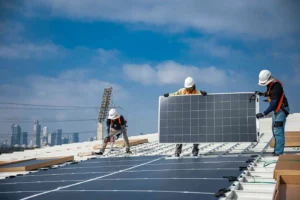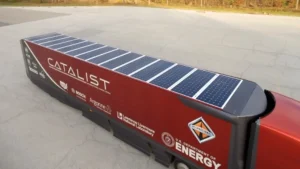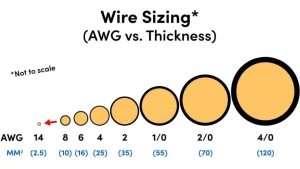Manufacturers continuously make incremental improvements to their solar panels to achieve higher unit energy output compared to previous and competitive models. Another effective method for enhancing system output is the use of solar trackers. Unlike fixed, tilted ground-mounted systems, solar trackers enable solar panels to follow the sun’s path throughout the day.
What are solar trackers and how do they work?
Solar tracking systems, also known as solar trackers or solar tracking systems, adjust the angles of solar panels to face the sun throughout the day, maximizing the efficiency of solar radiation absorption and increasing the electricity output of solar energy systems. These systems are typically used for ground-mounted solar panels and large standalone solar installations like solar trees, while they are less common in most residential solar projects.
When solar panels are exposed to sunlight, the angle of incidence, which is the angle between the sun’s rays and the surface of the panel, affects the efficiency with which the panel converts sunlight into electricity. A smaller angle of incidence results in higher energy production. Solar trackers achieve this by automatically adjusting the orientation of the panels, allowing sunlight to strike the panels vertically, thus minimizing the angle of incidence.
Solar tracking systems employ various technologies, including active tracking and passive tracking. Active trackers use drive mechanisms, often linked to sensors and GPS coordinates, to detect the sun’s position and automatically adjust the orientation of the panels. Some tracker models also feature small independent solar panels dedicated to powering the tracking system.
On the other hand, passive trackers operate by utilizing the rotation of compressed gases and liquids that flow through channels to avoid direct exposure to sunlight. This technology aims to reduce energy consumption and maintenance costs.
![]()
Single-axis and dual-axis solar trackers.
There are two types of solar tracking systems based on their motion: single-axis and dual-axis.
Single-axis solar tracker.
Single-axis solar trackers achieve automatic solar tracking by moving solar panels along a single axis, typically aligned with the north-south direction. This setup allows the panels to follow the sun’s path from east to west, maintaining the optimal angle for increased energy production, without the need for adding more solar panels.
Although the initial installation costs and ongoing maintenance expenses for single-axis trackers are relatively high, they can significantly enhance the efficiency of solar panel systems, quickly offsetting these costs. Installing single-axis tracking systems is particularly crucial in regions with generally warm and dry climates and flat terrain.
Compared to dual-axis trackers, single-axis trackers produce slightly less energy per unit. However, they have a lower profile and require less installation space, making it possible to create more compact systems with simpler operation and maintenance models.
Sigle-axis trackers can be classified into two types: centralized and decentralized. Both centralized and decentralized trackers use motors to move the panels between rows. In decentralized systems, each row has its own motor. In some cases, there are examples where each group of racks is equipped with motors, making it easier to adjust during installation and allowing them to track the sun independently, without being affected by neighboring modules.
Despite the higher initial costs of single-axis solar tracking systems, they can significantly boost the energy production of solar systems, making them a worthwhile investment in the long run.
Dual-axis solar trackers.
Dual-axis solar trackers have the capability to move solar panels on two axes, both north-south and east-west directions, to continuously track the sun’s position. This system utilizes algorithms and sensors to monitor variations in the sun’s height during seasonal changes, maximizing solar energy collection efficiency throughout the year, and surpassing the fixed angles of daily motion.
In general, dual-axis trackers, often manufactured by companies like AllEarth Renewables, are not commonly found in solar projects, even in large utility-scale installations. However, they may be suitable for certain commercial properties because they can generate up to 45% more electricity than traditional static solar panels. This is particularly beneficial for businesses with limited roof space, helping them meet their energy needs. In contrast, large-scale utility projects typically have sufficient land space and do not face the same rooftop space constraints, making dual-axis trackers less common.
Dual-axis trackers are more prevalent in residential and small commercial applications, and they are also becoming more common in utility-scale projects. Each dual-axis tracker is usually installed atop a single elevated pole to ensure that the solar panels can track a broader range of angles. These trackers can accommodate up to 20 solar panels each and utilize algorithms and sensors to track seasonal changes, sun height variations, and daily solar paths, thereby maximizing the efficiency of solar energy systems.
Active, manual, and passive solar trackers.
In addition to single-axis and dual-axis solar trackers, we can also classify solar trackers as active, manual, or passive. Key points: Active solar trackers use motors for movement, manual solar trackers require manual adjustment, and passive solar trackers utilize the sun for movement.
Active solar trackers.
Most solar tracking systems utilize active design. These systems rely on motors or mechanical devices to automatically adjust the panels. This mechanism ensures that solar panels can directly face the sun at different times, maximizing energy collection efficiency.
In particular:
– Active solar trackers use light sensors to perceive the intensity of sunlight.
– Subsequently, the system assesses the orientation of the solar modules based on this data and makes the necessary adjustments.
Active solar trackers excel in managing large and complex solar panel arrays, as they effectively track the sun’s position to ensure optimal energy collection.
Manual solar trackers.
Manual solar trackers allow you to physically adjust the panels throughout the day based on the sun’s movement. This type of tracker is beneficial because its maintenance costs are lower compared to active or passive trackers. However, they are often less practical as they require regular manual adjustment to align with the sun’s movement throughout the day.
Passive solar trackers.
Passive solar trackers do not require additional power; instead, they utilize the sun’s thermal energy to achieve tracking. Their operation relies on generating mechanical motion by heating an internal gas. When the gas is heated and expands on one side, it causes a piston to rise, tilting the solar panels toward the sunlight. As the sun sets, the cooling and compression of the gas lead to the panels rotating backward. This entire process relies entirely on solar thermal energy, without the need for extra electrical input.
Advantages and Disadvantages of Solar Trackers
Advantages of Solar Trackers
Compared to fixed solar panel arrays, tracking systems offer a higher level of energy output because they can follow the sun’s movement.
Various trackers provided by manufacturers like AllEarth Solar and First Sunergy allow you to find the equipment that best suits your needs.
Solar trackers are highly beneficial in areas with time-of-use electricity rates. During peak hours, they can produce more energy, which means you don’t have to pay for grid energy at the most expensive times.
Disadvantages of Solar Trackers
Solar trackers are quite expensive and can easily double project costs.
Solar trackers consist of moving parts, making them more susceptible to damage. This results in higher maintenance costs.
Deciding to install trackers may require additional site planning and preparation, including digging extra trenches and leveling the site.
Is a solar tracking system right for you?
Solar tracking systems are suitable for installations located in areas with ample sunlight. If you want to ensure that your solar panels follow the sun throughout the day, considering the installation of a solar tracking system can be a good choice.
Roof-mounted systems have relatively lower installation costs and do not require extra yard space, making them the preferred option for most homeowners looking to embrace renewable energy. As a result, most residential solar systems do not include solar trackers, as they may not be necessary. If your roof faces south, your solar panels are already oriented to capture the maximum sunlight, making additional tracking systems unnecessary. To maximize the potential of your solar system, consider choosing the most efficient solar panels available today
Solar tracking systems offer the greatest potential value in high-latitude regions, such as Alaska and some northern areas of the United States. Consequently, some solar customers may consider installing trackers in these regions. However, for most residents in the United States, the movement of the sun has a limited impact on panel production, resulting in limited economic benefits from tracking systems. Most customers are better off opting for roof-mounted arrays facing south or fixed ground-mounted systems.
Solar tracking systems are commonly used in large commercial projects, which are typically on a grand scale, exceeding 1 megawatt (MW). For these commercial-scale solar arrays, the increased yield over time is enough to offset the initial costs and maintenance expenses. Furthermore, commercial-scale solar projects are typically ground-mounted, making solar tracking systems a viable option.






